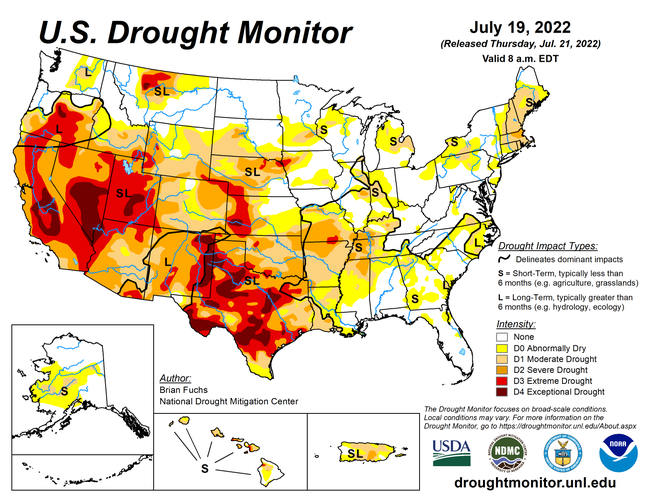Here’s a look at 5 headlines that you don’t want to miss.

Check out these five stories that are impacting beef production and ranches this week.
1. Hot dry summer continues
There is no doubt, the weather has been a major story not just for ranchers in Texas but across the country. Wildfires, no rain and hot temperatures have plagued the USA. The dry conditions continue to expand eastward.

2. Thousands of U.S. cattle buried, dumped at Kansas landfill
Top U.S. cattle feeding companies sent 1,000-pound carcasses to a Kansas landfill, where they were mixed with trash, after a June heatwave killed thousands of cows, documents seen by Reuters show.
Other cattle were buried in unlined graves, a feeding company said.
Neither is a typical method for disposing of bodies. But so many cows died in the unusual heat and humidity that facilities that normally convert carcasses into pet food and fertilizer products were overwhelmed, prompting the state government and cattle feeders to take emergency measures.
3. Lumpy skin disease kills 999 cattle in Gujarat
Nearly 1,000 cattle, predominantly buffaloes and cows, have died across the western state of Gujarat. A total of 999 cattle have so far died from lumpy skin disease, the state’s Agriculture and Animal Husbandry Minister Raghavji Patel said on July 26. The viral disease has spread to over 37,000 animals and is now present in 14 districts in the state.
Lumpy skin disease is a viral bovine disease caused by a virus belonging to the same family of viruses that causes smallpox and monkeypox. The disease results in fever, enlarged superficial lymph nodes and multiple nodules across the surface of the skin. These nodules also form on mucous membranes inside the body and as on organs like the eyes, nose, mouth, rectum, udder and genitalia.attle sting operation snared Loving a cattle sting operation snared Loving County Judge Skeet Jones
4. How a cattle sting operation snared a county judge
A cattle rustling sting resulted in the arrests of the top elected official and three ranch hands in the least-populated county in the continental United States.
On a December day in 2021, Loving County Judge Skeet Jones, 71, climbed atop an oilfield tank surrounded by wide-open Texas desert dressed in a business suit and toting a pair of binoculars, hoping to spot an elusive black bull.
What Jones most likely didn’t realize from his steel perch as he scanned the horizon: He, too, was being watched as part of a cattle-rustling sting operation devised by special rangers with the Texas and Southwestern Cattle Raisers Association.
The backstory of what led to the arrests of Jones, a former sheriff’s deputy and two ranch hands in May is chronicled in a stack of warrants obtained by NBC News. The documents detail a yearlong investigation, replete with confidential informants and a sting operation involving a reddish-brown cow, her calf and the black yearling bull — all equipped by the special rangers with microchips.
The warrants allege that Jones and the ranch hands rounded up stray livestock in Loving and Pecos counties and sold them at auctions in Texas, Oklahoma and New Mexico without first notifying the Sheriff’s Office to find their rightful owners — a violation of a state law.
Jones, the scion of a prominent ranching family and the top elected official in this sparsely populated West Texas county for the past 15 years, is charged with three felony counts of livestock theft and one count of engaging in organized crime — potentially facing decades in prison if convicted. (Jones and the other defendants declined to comment. Jones’ lawyer did not return phone calls.)
But Jones’ supporters say he was set up. “There’s no question about that,” said Steve Simonsen, who is the Loving County attorney and married to a cousin of Jones’. “If you’re a special ranger and you’re really interested in stopping rustling, you don’t sneak out in the middle of the night and unload a bunch of cattle that you secretly microchipped,” Simonsen said.
Jeremy Fuchs, a spokesman for the Texas and Southwestern Cattle Raisers Association, a cadre of peace officers who specialize in agricultural crimes, said the organization stands by the arrests of the judge and the other defendants. Fuchs said the investigation is ongoing and could result in more charges.
5. Bion's New Technology Will Make Beef Sustainable and Profitable for Cattle Feeders & Ranchers
Bion Environmental Technologies, Inc., a developer of advanced livestock waste treatment technology that dramatically reduces environmental impacts and recovers valuable resources, announced a letter of intent with Ribbonwire Ranch to build a 15,000 head sustainable beef cattle feeding operation in Dalhart, Texas. The facility will include innovative barn systems, anaerobic digesters and Bion's cutting edge waste treatment technology.
Bion and Ribbonwire will work together to create a definitive Joint Venture this Fall, allowing plans to move forward to commence construction of the Dalhart sustainable beef facility during 2023. The LOI contains a provision to allow expansion of the project to four phases, representing 60,000 head capacity or annual production of 180,000 head. Bion expects formal agreements with foodservice and retail customers over the next few months.
The Dalhart facility will be developed to produce blockchain-verified sustainable beef, reduce the stress on cattle caused by extreme weather and temperatures, while remediating the environmental impacts associated with cattle Concentrated Animal Feeding Operations (CAFOs). Bion's patented technology will refine the waste stream into valuable coproducts that include clean water, renewable natural gas (RNG), and organic fertilizer products. The revenues generated from these new product lines will transform a cattle feeder from a marginally profitable business into a lucrative one.
About the Author(s)
You May Also Like



